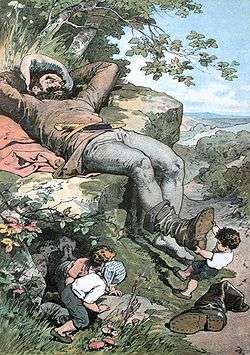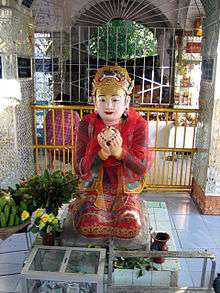Ogre

An ogre (feminine ogress) is a legendary monster usually depicted as a large, hideous, manlike being that eats ordinary human beings, especially infants and children. Ogres frequently feature in mythology, folklore, and fiction throughout the world. They appear in many classic works of literature, and are most often associated in fairy tales and legend with a taste for infants.
In mythology, ogres are often depicted as inhumanly large and tall and having a disproportionately large head, abundant hair, unusually colored skin, a voracious appetite, and a strong body. Ogres are closely linked with giants and with human cannibals in mythology. In both folklore and fiction, giants are often given ogrish traits (such as the giants in "Jack and the Beanstalk" and "Jack the Giant Killer", the Giant Despair in The Pilgrim's Progress, and the jötnar of Norse mythology); while ogres may be given giantish traits.
Famous examples of ogres in folklore include the ogre in Puss and Boots and the ogre in "Hop-o'-My-Thumb"; and in fiction, Shrek and Fiona from Shrek. Other characters sometimes described as ogres include the title character from "Bluebeard", the Beast from "Beauty and the Beast", Grendel from "Beowulf", Polyphemus the Cyclops from Homer's Odyssey, the cyclops in "Sinbad the Sailor", and the oni of Japanese folklore.
Etymology

The word ogre is of French origin, originally derived from the name of the Etruscan god Orcus, who fed on human flesh. Its earliest attestation is in Chrétien de Troyes' late 12th-century verse romance Perceval, li contes del graal, which contains the lines:
Et s'est escrit que il ert ancore
que toz li reaumes de Logres,
qui jadis fu la terre as ogres,
ert destruite par cele lance.
"And it is written that he will come again,
to all the realms of Logres,
known as the land of ogres,
and destroy them with that lance."
The ogres in this rhyme may refer to the ogres who, in the pseudohistorical work History of the Kings of Britain by Geoffrey of Monmouth, were the inhabitants of Britain prior to human settlement. despite that ogres still feature prominently in Cornish Folklore. Ogre could possibly derive from the biblical Og, last of the giants (or from the Greek river god Oiagros, father of Orpheus).

The word ogre came into wider usage in the works of Charles Perrault (1628–1703) or Marie-Catherine Jumelle de Berneville, Comtesse d' Aulnoy (1650–1705), both of whom were French authors. Other sources say that the name is derived from the word Hongrois, which means Hungarian, as of western cultures referred to Hungarians as a kind of monstrosity.[1] The word ogre is thought to have been popularized by the works of Italian author Giambattista Basile (1575–1632), who used the Neapolitan word uerco, or in standard Italian, orco. This word is documented[2] in earlier Italian works (Fazio degli Uberti, 14th century; Luigi Pulci, 15th century; Ludovico Ariosto, 15th–16th centuries) and has even older cognates with the Latin orcus and the Old English orcnēas found in Beowulf lines 112–113, which inspired J.R.R. Tolkien's Orc.[3] All these words may derive from a shared Indo-European mythological concept (as Tolkien himself speculated, as cited by Tom Shippey, The Road to Middle-earth, 45). Some see the French myth of the ogre as being inspired by the real-life crimes of Gilles de Rais.[4]
The first appearance of the word ogre in Perrault's work occurred in his Histoires ou Contes du temps Passé (1696). It later appeared in several of his other fairy tales, many of which were based on the Neapolitan tales of Basile. The first example of a female ogre being referred to as an ogress is found in his version of Sleeping Beauty, where it is spelled ogresse. Madame d'Aulnoy first employed the word ogre in her story L'Orangier et l'Abeille (1698), and was the first to use the word ogree to refer to the creature's offspring.
Fairy tales that feature ogres
- Hop-o'-My-Thumb
- Puss in Boots
- Sleeping Beauty
- The Bee and the Orange Tree
- Tale of the Ogre
- The Flea
- The Enchanted Doe
- "Violet"
- The Dove
- Corvetto
- The Three Crowns
- Liisa and the Prince
- Mr Miacca
- The Red Ogre Who Cried
Ogres in popular culture
- An ogre named Golithos is one of the main antagonists in The Marvellous Land of Snergs.
- Ogres are mentioned in the fairy tales of hobbits in The Hobbit.
- Ogres make an appearance in The Chronicles of Narnia: The Lion, the Witch and the Wardrobe film, The Lion, the Witch, and the Wardrobe book and Prince Caspian. They serve the White Witch faithfully as soldiers and prison guards. In Prince Caspian they are revealed to still exist in Narnia, but are not trusted by the Narnians.
- An ogre named Shrek is the eponymous protagonist in the Shrek film series. In contrast to the traditional depiction, he is a grumpy, sarcastic but good-hearted character who only refers to eating people in a joking manner.
- An ogre named Mulgarath is the main antagonist in The Spiderwick Chronicles, wherein the shapeshifting ability from the Puss in Boots story is shared by all ogres.
- Ogres are units for the Orc faction in Warlords Battlecry video games.
- Ogres are enemies in The Elder Scrolls: Oblivion.
- Ogres make an appearance as shock troops and pillagers from Mount Gundabad in The Hobbit: The Battle of the Five Armies.
- Ogres are a race in the Dungeons and Dragons role-playing game.
Gallery
In illustration

 Bluebeard and his wife
Bluebeard and his wife.jpg) The ogre and his wife in "Hop-o'-My-Thumb"
The ogre and his wife in "Hop-o'-My-Thumb" Hop-o'-My-Thumb's ogre
Hop-o'-My-Thumb's ogre- Hop-o'-My-Thumb's ogre
 Hop-o'-My-Thumb's ogre
Hop-o'-My-Thumb's ogre The Beast and Beauty from "Beauty and the Beast"
The Beast and Beauty from "Beauty and the Beast" An oni
An oni An oni
An oni An oni
An oni
In sculpture
 The ogre from "Hop-o'-My-Thumb" at Efteling
The ogre from "Hop-o'-My-Thumb" at Efteling An ogre king represented at Mandalay Hill
An ogre king represented at Mandalay Hill The ogress Sanda Muhki represented at Mandalay Hill
The ogress Sanda Muhki represented at Mandalay Hill An oni
An oni An oni in Beppu
An oni in Beppu
See also
| Look up ogre in Wiktionary, the free dictionary. |
![]() Media related to Ogre at Wikimedia Commons
Media related to Ogre at Wikimedia Commons
References
- Rose, Carol. Giants, Monsters, & Dragons: An Encyclopedia of Folklore, Legend, and Myth. New York: W. W. Norton & Company, 2001. ISBN 0-393-32211-4
- Shippey, Tom. The Road to Middle-earth. London: HarperCollins, 1992 (rev.). ISBN 0-261-10275-3
- South, Malcolm, ed. Mythical and Fabulous Creatures: A Source Book and Research Guide. Westport, CT: Greenwood Press, 1987. Reprint, New York: Peter Bedrick Books, 1988. ISBN 0-87226-208-1
- Kathrine Mary Briggs The Fairies in Tradition and Literature
- "Ogre." Encyclopædia Britannica. 2006. Encyclopædia Britannica Online. 15 May 2006, search.eb.com
Notes
- ↑ Dictionnaire de l'Académie française (1932–35)
- ↑ Vocabolario Degli Accademici Della Crusca
- ↑ "Beowulf". Humanities.mcmaster.ca. Retrieved 2012-03-28.
- ↑ heresie.com